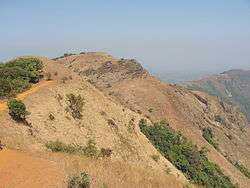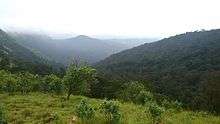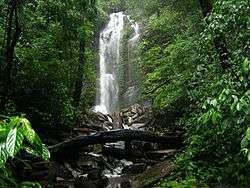Kodachadri
| Kodachadri | |
|---|---|
| ಕೊಡಚಾದ್ರಿ | |
|
| |
| Highest point | |
| Elevation | 1,343 m (4,406 ft) |
| Coordinates | 13°51′39″N 74°52′29″E / 13.86083°N 74.87472°ECoordinates: 13°51′39″N 74°52′29″E / 13.86083°N 74.87472°E |
| Geography | |
 Kodachadri Location in Karnataka | |
| Location | Karnataka, India |
| Parent range | Western Ghats |
| Climbing | |
| First ascent | Historic times |
| Easiest route | via Nagodi |

Kodachadri is a mountain peak with dense forests (elevation - 1,343 metres above sea level)[2] in the Western Ghats in South India (Shivamogga Dist., Karnataka State). It is declared as natural heritage site by Government Karnataka.[3] and it is 10th highest peak of Karnataka.
Etymology
The name comes from native word "Kodacha" or "Kodashi" which means hill of Kutaja flowers and "Adri" a Sanskrit word, both combined together coined the word Kodachadri. Kutaja in Sanskrit means Girimallika or Jasmine of the hill. The hilly region that is full of 'Jasmine of the hills' plants is "Kutajadri". It is also called "Kutachadri" and "Kodashi Parvatha".[4]
Location
Kodachadri forms a background to the famous temple of Mookambika in Kollur.[5] It is located at a distance of 21 km from Kollur[5] and 15 km from Nagodi village, in Hosanagara taluk. There are different routes to reach the Peak of Kodachadri and the difficulty varies highly with respect to the route chosen. However it is challenging to reach the peak in monsoon due to heavy rains that make the routes slippery. Kodachadri receives an annual rain fall of 500 cm to 750 cm and it rains for about eight months in a year.[6]
Flora and Fauna
Situated in the middle of the Mookambika National Park and considered as a biodiversity hotspot,[5] it is home to several endemic and endangered species of flora and fauna. The peak is barren due to strong winds and the thick forest cover at the base makes the peak invisible from lower ground level and also several other smaller peaks and hills exist around the peak. The important animal life include Malabar langur, Malabar pied hornbill, Malabar grey hornbill, paradise flycatcher, Indian tiger, Indian leopard, Indian elephant,[7] hyena, gaur, Indian rock python and many more, of which several are threatened.[5]
History
Kodachadri seems to have attracted the attention of humankind since early prehistory. Several monolithic structures or menhirs were built here in prehistoric times. Rocks with dimensions greater than 12 feet were used in their construction. These large structure can be found just 20 Kilometers outside of Nagara-Nilsakal. A temple dedicated to the Ancient Mother Goddess Mookambika is located near the top of the peak. The temple is a popular destination for Hindu pilgrims and it is said to stand where thousands of years ago Mookambika fought and killed the demon Mookasura. In Historic times, people used to trek from Nagara state, a nearby place and Europeans trekked to the peak during 19th Century. Lewin Bentham Bowring, who served as Commissioner of Mysore between 1862 and 1870, records that Kodachadri is "clothed with splendid forests, and the ascent is very steep indeed in one place near foot....The view from the top of the hill, which has a bluff appearance from the distance, though it is as sharp as a knife in reality, is very fine, commanding a long stretch of great Ghat range, a considerable portion of Canara (Kanara), and a vide view over Malnad".[8] He further records that, Kodachadri is visible from Merti Peak near Sringeri.[8]

Kodachadri is visited by locals and Keralites in large numbers since long time. Sage Adi Shankara is said to have visited this place, meditated here[5] and he also established a temple at Kollur. A small temple called Sarvajnapeetha, built with stone is dedicated to Adi Shankara at the top of Kodachadri.[5] Some of the pilgrims from South Indian states who visit Kollur take a trek to Kodachadri also. Dr. K. Shivarama Karantha, noted writer of Udupi District trekked to Kodachadri in 1940s and appreciated the natural beauty of this place by placing Kodachadri as most beautiful of three mountain peaks of coastal Karnataka (the other two being Kuduremukh and Kumara Parvata).[9]
Forests
The Shola Forests and thick forest cover Kodachadri and the nearby hills and the place has a cool and beautiful landscape.[5] The forest of Kodachadri and nearby hills is tropical rain forest as seen all along Western Ghats, a World Heritage site.[3]
Iron ore
Kodachadri hill contains iron ore in its soil[10] and test digging was also done here during 20th century and it was identified that the stones found here have magnetic properties.[11] However commercial mining in large scale did not take place at Kodachadri, though there are efforts to lease out the surrounding hills to mining companies to mine manganese and iron and local people have strongly opposed such a move in view of possible environmental damage.[12] In such anti-mining protests, local people under the leadership of Shri Raghaveshwara Bharathi of Ramachandrapura Mutt, Shivamogga district and environmentalist Ananth Hegde Ashisara demanded ban on all mining activities in Ambaragudda, which is near Kodachadri and other hills of the area.[12]
Places of interest
Sarvajna peetha
Sarvajna Peeth is a small temple like structure near the peak where Adi Shankara meditated.[5] This small structure bears a name which is similar to Sarvajñapīṭha, also called Sharada Peeth of Jammu and Kashmir.[13] which was visited by Adi Shankara during his long spiritual journey, where he defeated other scholars in philosophical debate and opened the southern door of the temple. Another temple is located near travellers' bungalow and is believed to be the moola sthana (the origin) of Sri Mookambika Devi. From this spot, it is a 2 km trek to the peak. Just below the peak, an almost vertical path leads to a small cave called Chitramoola, from where the Mookambika temple of Kollur is visible.
Ganesha Guha
Ganesha Guha is near the trekking path to Sarvajna peetha
Iron Pillar
One iron pillar of about 40 feet length is planted erect in front of Moola Mookambika Temple near peak of Kodachadri and it is compared with massive similar historic iron pillars located at Dhar, Mount Abu etc.[14] Devotees believe that this is the trishula used by goddess Mookambika to slay a demon called Mookasura as per local tradition. Indian scientists from IGCAR Kalpakkam and KREC(Now NITK), Suratkal, Mangalore conducted a test on the Iron pillar and found that it was made from traditional Indian metallurgical skills and not from modern casting methods.[15] It is found made of pure iron.[15] It is also found to be less affected by corrosion, despite of humid conditions prevailing there due to heavy rains.[6][16] This iron pillar is considered as testimony of ancient Indian iron craftmanship.[14]
Hidlumane Falls
Around 5 km from Kodachadri is Hidlumane Waterfalls and it can be reached by trekking on a bridle path, which involves a little adventurous trekking.[7]

.
Arasinagundi falls
Another water falls in deep forest is Arasinagundi falls which 6 km from Kollur, at the bottom of Kodachadri near Dhalli village.[17]
Belakallu theertha
One more waterfalls called Belakallu theertha is located near Mudur, Jadkal (and 15 km from Kollur) and at the bottom of Kodachadri on southern side and involves easy trekking to reach.[17]
Nagara fort
Nagara Fort is around 25 km from Kodachadri where an old fort built during 18th Century is located[8] and the landscape created out of backwaters of Linganamakki Dam on Sharavathi River surrounds Nagara town.
Sunset
The sunset watched from Kodachadri peak on a clear day is an enchanting experience.[5] The Arabian Sea is visible from the peak on a cloudless day and sun literally goes down into the sea and due to the proximity to sea, the shape of golden sun changes every minute. At the beginning it looks like an inverted pot, then like a vessel, a hat, a ring with double edges and so many shapes are visible which is an interesting sight. The sunrise is also seen from another hillock behind the Tourist Bungalow is also beautiful[5] and the hillock is called Venkatarayana Durga, with some remote connection to some Palegara Kings who ruled the surrounding places. During sunrise, the plateau below is usually covered with mist and it looks like a vast sea of curd with some high peaks peeping out of the misty plateau.
Trekking in Kodachadri
Trekking to Kodachadri peak starts from Nagodi village or Nittur, Shivamogga village which are located at the base of Kodachadri. Tented overnight Camping and Camp fire is strictly not allowed since January 2015, Once you enter the check Post in the foothill as this comes under the Forest Department, Govt. of Karnataka (Liquor will be detained at the Check Post). However, in case you need to spend a night on top you have inspection bungalow maintained by the government of Karnataka and a temple priest's house, with simple food on request. There is little other accommodation at Kodachadri. Kollur (21 km) has several guest houses and lodges as well as homestay accommodations. The nearest city, Kundapura, has good lodging accommodations. Best time to trek would be post monsoon, between September and March. It is recommended to avoid jeep trails during trekking, as the road normally experiences heavy vehicular traffic.
Transportation
From Bangalore, one has to go to Shivamogga (285 km) and from there, one can take public transport to reach Nagodi village (Hosanagara Taluk). From Udupi, it is three hours journey to Nagodi village, from where trekking starts.
Kodachadri peak is connected with an all rough jeep road (partially metalled) on which only jeeps can travel. As this hilly road is not maintained properly, only expert local jeep drivers can take the jeep to the top. Jeeps are available for hire at Kollur and at Kattinahole village near Kodachadri base. Motorcycle riding on this highly uneven, steep, mud track with sharp hairpin curves with gradients, may be challenging and risky. However, Government departments have commenced construction of a quality road to top, after a stay (by private tourist operators) opposing construction of road is vacated(during 2011) and this proposed work includes overall development of Kodachadri area.[5] Kundapur is the nearest major railway station which is in Mangalore-Mumbai Konkan railway route.
See also
Gallery
- Photos related to Kodachadri
 Kudachadri - scene1
Kudachadri - scene1 Kudachadri - scene2
Kudachadri - scene2 Sarvajna peeta at the peak of Kodachadri,western view
Sarvajna peeta at the peak of Kodachadri,western view Kudachadri GaneshaGuha
Kudachadri GaneshaGuha On top of the Kodachadri mountains.
On top of the Kodachadri mountains. Trekking trail on top of the mountain
Trekking trail on top of the mountain Kodachadri landscape
Kodachadri landscape Hills seen from top of the mountain
Hills seen from top of the mountain
References
- ↑ http://www.karnataka.com/kollur/kodachadri-trek/
- ↑ Maps of, India. "Kodachadri,Karnataka". mapsofindia.com. Retrieved 12 August 2012.
- 1 2 Kaggere, Niranjan (2012). "Kodachadri now a Heritage site". Times of India- mobile e paper. Retrieved 5 October 2012.
- ↑ Durgadas, Mukhopadhyay (1978). Lesser known forms of performing arts in India. Sterling. p. 74. ISBN 978-0-842-61004-9.
- 1 2 3 4 5 6 7 8 9 10 11 C.V., Raghavendra Rao (11 April 2011). "Now, tourists can visit Kodachadri hills". Bangalore: The Times of India. Retrieved 12 August 2012.
- 1 2 NML, Technical Journal (1995). NML Technical Journal Vol.37. New Delhi: National Metallurgical Laboratory (India). p. 133.
- 1 2 The, Hindu(news) (21 November 2011). "Sighting of wild elephant creates panic". Bangalore: The Hindu(newspaper). Retrieved 12 August 2012.
- 1 2 3 Lewin Benthan, Bowring (1871). Eastern experiences. London: H.S.King. pp. 132, 133, 150.
- ↑ Karanth, K.Shivarama (translated by H.Y. Sharada Prasad) (1993). Ten faces of a crazy mind : autobiography (1st ed.). Bombay: Bharatiya Vidya Bhavan. pp. 158, 217. ISBN 9788172760236.
- ↑ Mysore, Govt. of (1964). Mysore Ports. Bangalore: Dept. of Publicity and Information.
- ↑ B.L., Rice (2001) [1887]. Gazetteer of Mysore - 2 Vols. London: Asian Educational Service, New Delhi (Reprint). pp. 417, 459–62.
- 1 2 Special, Correspondent (17 August 2005). "Andolan seeks restoration of ban on mining at Ambargudda". Bangalore: The Hindu. Retrieved 11 August 2012.
- ↑ kumar, kondur. "Pics of Sharada or sarasvati devi shakthi peetha in POK". shakthipeethas.org. Retrieved 12 August 2012.
- 1 2 Tripathi, Vibha (2001). The age of iron in South Asia: legacy and tradition. New Delhi: Aryan Books International. p. 130. ISBN 978-8-173-05208-8.
- 1 2
- ↑ Srivatsan, T.S. (2009). Processing and fabrication of advanced materials, XVII: Volume One. New Delhi: I K International Pvt Ltd. p. 65. ISBN 978-8-190-77700-1.
- 1 2 Ganesh, Prabhu; Ganesh Prabhu (12 July 2011). "Enchanting Kudlu Thirtha". Bangalore: The Hindu (newspaper). thehindu.com. Retrieved 12 August 2012.
External links
| Wikimedia Commons has media related to Kodachadri. |